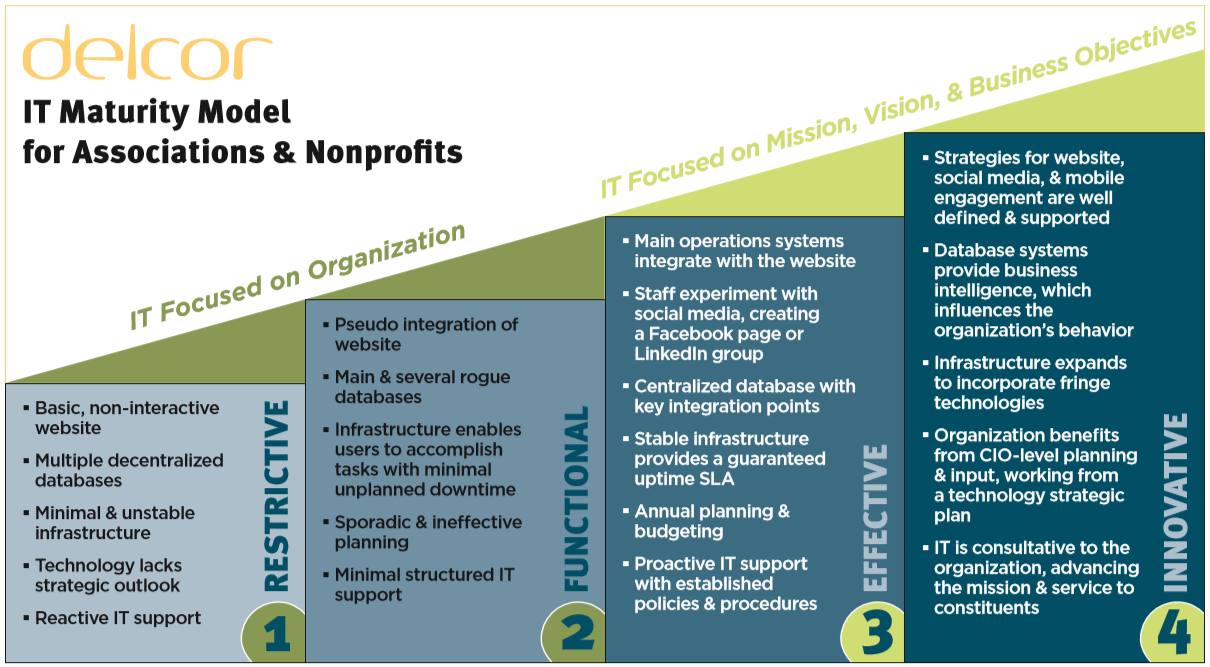2020 is providing member-based organizations with opportunities as well as challenges, and the technologists at DelCor and Gravitate teamed up on September 15th to offer something that many associations will find most welcome – insights into how to make meaningful improvements to your processes and your member offerings in this very unusual year, presented by those that are actually doing it.
A panel of four profoundly accomplished association technologists convened to discuss how IT can help associations substantially improve the way information is made available throughout the organization and the way it is used to improve both internal processes and actual offerings to members/constituents.
Each member of this panel has been deeply involved in achieving transformational changes within associations in 2020, and each has seen that data and analytics is central to this process. The panel:
- Andrew Huling, CTO of Gravitate
- Dave Coriale, President and Co-Founder of DelCor
- Mark Wilson, CIO of the American College of Obstetricians and Gynecologists (ACOG)
- John McKenney, Director of Platform Engineering at the American Association for Cancer Research (AACR)
Key Takeaway #1: Use Big-Picture Perspective to (Quickly) Establish a Foundation
Better IT is one of the only ways to make meaningful improvement within an association, and achieving this requires something extremely healthy for just about any organization: a discussion of and consensus around desired outcomes, significant obstacles, and the best ways to deliver these outcomes.
Dave Coriale of DelCor realized 12 years ago that many associations benefit from using a framework to assess these elements, and created the Association IT Maturity Model for this purpose. Among other uses, it was adopted in 2015 by the ASAE Foundation for an industry-wide research project.
The IT Maturity Model segments the state of IT and its ability to support the organization into 4 stages:

Source: https://www.delcor.com/resources/it-maturity-model
The big-picture perspective provided by this model can be useful in helping leaders and staff throughout an organization gain a better understanding of their IT situation and how to improve it. During the panel discussion, Mark and John discussed when they figured out that their organizations needed some changes and how they used maturity model concepts to reach their goal of more data driven decisions .
At AACR, John McKenney found that a big-picture perspective was needed to break the cycle of IT being focused purely on one project after another. Pausing and assessing who owns each data source and how changes to systems take place is the necessary first step. They launched an initiative to identify and think through the uses and treatment of data, and this proved transformative. The AACR defined this as “data normalization” – an achievable first step.
At ACOG, Mark Wilson leads both the IT and Membership teams, which is unusual and provides a unique point of view. He realized that their necessary first step was agreement on definitions and key terms – basic yet powerful data governance (and infrastructure that supports this) allows for consistent reporting, apples-to-apples conversations across departments, and is a first step in what ACOG thinks of as “data enablement.” The process of reaching agreement across departments about common definitions is also a wonderful first step in creating a culture of appreciating data.
As CTO of Gravitate, Andrew Huling helps associations adopt and use the Nucleus data analytics solution and noted the beneficial cohesion that develops across business units when these foundational conversations about data and its uses take place. This awareness also means that there are, in effect, no more “one off” projects in IT, no isolated decisions within departments to begin using new software or apps without a quick conversation about potential impact on data and data quality. Just as an external or third party can often drive conversations that might be difficult otherwise, bringing in a data solution designed specifically to bring together data from across the association leads to healthy (and vital) awareness among staff and leadership that everything to do with data is interconnected and that major improvements are rapidly possible through joint effort.
This awareness sets a solid foundation and progress may begin.
Takeaway #2 – Decide on your “North Star” and How You Want to Move Forward
At AACR, they saw two possible approaches to making fundamental improvements: 1) stop everything and build from the ground up through a consultant-style process, or 2) “peel the onion“ by addressing data inconsistencies or inefficiencies one at a time until no more problem areas remain. They chose the latter. As part of doing this, they created a “Business Engineering” team (with representatives from both IT and business units) and decided the first step in peeling the onion was to decide which processes should be automated and why, knowing that this would make clear where one process is dependent on (and slowed down by) another and when any sort of human involvement is currently required and could potentially be made unnecessary. They started with one simple query-style report that took three and a half weeks to build.
At ACOG, Mark had his teams focus on “member touchpoints” and made the top priority looking for low-hanging fruit projects in Member Services. His goal was to improve member experience and let discoveries made there drive the fixing of larger issues. An example was the 4-month process that members had to go through to apply to become a “Fellow”– changes to this required not only new technical capabilities but also board-level approval and changes to the ACOG bylaws.
The quick wins that were achieved through both of these approaches also have the tremendous benefit of rapidly building trust in the data initiative and the IT team overall. At Gravitate, Andrew has seen that there are often individual staff members within associations that are hesitant to adopt new methods until they see for themselves that the new process or new tool provides a better way. He has led Nucleus development to achieve this, making sure that users begin seeing real benefit the very first time they log into the system.
This building of trust does not take place only at the beginning – DelCor tracked trust in the IT group at client organizations and compared it to their stage in the IT Maturity Model and found parallel lines – the levels of trust enjoyed by the IT department is correlated directly to IT capabilities and how well they are able to serve the organization as a whole. Relationships continue to deepen and improve, which is incredibly healthy for the organization.
Final Thought:
Mark shared a fantastic quote from one of his colleagues about organizational evolution. She asked him, “When is the best time to plant a tree?” when he had no answer, she told him, “20 years ago.” Then she asked him, “When is the second-best time? Today.”
It all starts with a vision – a North Star objective that everyone is aware of and driving towards achieving. Having the perspective of a framework like the Association IT Maturity Model is extremely helpful in understanding the big picture, and the introduction of (and daily staff interaction with) a data analytics solution like Nucleus delivers quick wins and maintains momentum.


